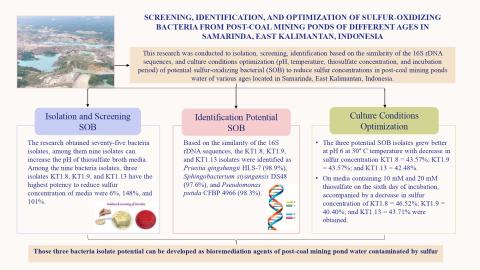You are here
Screening, Identification, and Optimization of Sulfur-Oxidizing Bacteria from Post-coal Mining Ponds of Different Ages in Samarinda, East Kalimantan, Indonesia

This research was conducted to isolation, screening, identification, and culture conditions optimization (pH, temperature, thiosulfate concentration, and incubation period) of potential sulfur-oxidizing bacterial (SOB) to reduce sulfur concentrations in post-coal mining ponds water of various ages located in Samarinda, East Kalimantan, Indonesia. The ponds used in this study were ponds < 5 years old and > 20 years old. The research obtained seventy-five bacteria isolates, among them nine isolates can increase the pH of thiosulfate broth media. Among the nine bacteria isolates, three isolates KT1.8, KT1.9, and KT1.13 have the highest potency to reduce sulfur concentration of media were 6%, 148%, and 101%. Based on the similarity of the 16S rDNA sequences, the KT1.8, KT1.9, and KT1.13 isolates were identified as Priestia qingshengii HLS-7 (98.9%), Sphingobacterium siyangensis DS48 (97.6%), and Pseudomonas putida CFBP 4966 (98.3%). The three potential SOB isolates grew better at pH 6 at 30° C temperature with the growth of KT1.8 = 146x1014 cell/mL; KT1.9 = 81x107 cell/mL; and KT1.13 = 33x107 cell/mL; decrease in sulfur concentration KT1.8 = 43.57%; KT1.9 = 43.57%; and KT1.13 = 42.48%. On media containing 10 mM and 20 mM thiosulfate on the sixth day of incubation, cell density isolates KT1.8 = 98x1012 cell/mL; KT1.9 = 25x107 cell/mL; and KT1.13 = 85x106 cell/mL; accompanied by a decrease in sulfur concentration of KT1.8 = 46.52%; KT1.9 = 40.40%; and KT1.13 = 43.71% were obtained. Those three bacteria isolate potential can be developed as bioremediation agents of post-coal mining pond water contaminated by sulfur.
